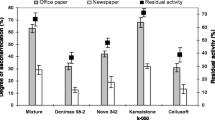Abstract
Used paper, a potential resource of alternative energy, can be recycled but mostly it forms a significant component of solid waste. Used office paper, foolscap paper, filter paper and newspaper have been treated with cellulase from Trichoderma reesei and Penicillium funiculosum to bioconvert their cellulose component into sugars. Both non-pretreated and pretreated paper was incubated successively with the two cellulases during four consecutive incubation periods of 1 h each. The amount of sugars released during this sequential treatment was compared with the total sugar produced during a 4 h period of continuous incubation with each enzyme system independently. Pre-treatment milling of paper proved to effectively increase the sugar formation under all incubation conditions. Successive incubation with the two enzyme systems of both non-pretreated and pretreated paper materials was more efficient than the corresponding continuous bioconversion. The highest relative sugar yield was experienced during successive treatment of pretreated materials when T. reesei cellulase initiated the degradation. However, maximum bioconversion of pretreated newspaper was obtained when P. funiculosum initiated degradation. Pretreated foolscap paper was the most susceptible substrate with maximum bioconversion when exposed to both forms of successive cellulase treatment.
Similar content being viewed by others
References
Agunwamba, J.C. (1998) Solid waste management in Nigeria: problems and issues. Environ. Manage. 22(6), 849–56.
Andersen, S.L. (1997) The outer limits of paper recovery and recycling. Tappi J. 80(4), 59–62.
Block, D. (1999) Executive order and proposed bill will boost biobased products and bioenergy. Biocycle Magazine 40, 55–7.
Brown, R.M. and Saxena, I.M. (1996) Cellulose biosynthesis in higher plants. Trends Plant Sciences 1(5), 149–56.
Deschamps, F.C., Ramos, L.P. and Fontana, J.D. (1996) Pretreatment of sugarcane bagassa for enhanced digestion. Appl. Biochem. Biotechnol. 57–58, 171–82.
Fiedler, H. (1990) Dioxins: sources of environmental load and human exposure. Toxicol. Environ. Chem. 29, 157–234.
Goyal, A., Ghosh, B. and Eveleigh, D. (1991) Characteristics of fungal cellulases. Biores. Technol. 36, 37–50.
Jones, K.H. (1994) Comparing air emissions from landfills and WTE Plants. Solid Waste Technologies 8, 28–39.
Kai, Y., Maekawa, E., Nishida, T., Ogawa, Y., Tanzawa, S. and Teratani, F. (1997) Hydrolysis of water-soluble cellulose acetate prepared from waste newspaper by immobilized cellulase. J. Japan Wood Res. Soc. 43(11), 956–64.
Katzen, R. and Fowler, D.E. (1994) Ethanol from lignocellulosic wastes with utilization of recombinant bacteria. Appl. Biochem. Biotechnol. 45–46, 697–707.
Kaur, P.P., Arnmeja, I.S. and Singh, J. (1998) Enzymatic hydrolysis of rice straw by crude cellulase from Trichoderma reesei. Biores. Technol. 66(3), 267–69.
Kubicek, C.P., Messner, R., Guber, F., Mach, R.L. and Kubicek-Pranz, E.M. (1993) The Trichoderma cellulase regulatory puzzle: from the interior life of a secretory fungus. Enz. Microbiol. Technol. 15, 90–95.
Latif, F., Rajoka, M.I. and Malik, K.A. (1994) Saccharification of Leptochloa fusca (kallar grass straw) by thermostable cellulases. Biores. Technol. 50, 107–14.
Lee, K.C., Bulls, M., Holmes, J. and Barrier, J.W. (1997) Hybrid process for the conversion of lignocellulosic materials. Appl. Biochem. Biotechnol. 66(1), 1–23.
Louwrier, A. (1998) Industrial products—return to carbohydrate-based industries. Biotechnol. Appl. Biochem. 27, 1–8.
Lowry, O.H., Rosebrough, N.J., Farr, A.L. and Randall, R.J. (1951) Protein measurements with the Folin phenol reagent. J. Biol. Chem. 193, 265–75.
Luo, L., Xia, L., Lin, J. and Cen, P. (1997) Kinetics of simultaneous saccharification and lactic acid fermentation processes. Biotechnol. Prog. 13(6), 762–67.
Lynch, J.M. (1992) Substrate availability in the production of composts. In Proceedings of the International Composting Research Symposium. H.A.J. Hoitink, and H. Keener, (eds.), pp. 24–35.
Miller, G.L., Blum, R., Glennon, W.E. and Burton, A.L. (1959) Measurements of carboxymethylcellulase activity. Anal. Biochem. 2, 127–32.
Nidetzky, B., Steiner, W., Hayn, M. and Claessens, M. (1994) Cellulose hydrolysis by the cellulases from Trichoderma reesei: a new model for synergistic interaction. Biochem. J. 298(3), 705–10.
van Wyk, J.P.H. (1997) Thermostability of cellulase from Penicillium funiculosum. Biotechnol. Lett. 116(6), 385–86.
van Wyk, J.P.H. and Mogale, A.M. (1998) Saccharification of paper materials by mixtures of cellulase from Penicillium funiculosum and Aspergillus niger. Australasian Biotechnol. 8(6), 357–59.
Wood, B.E., Aldrich, A.C. and Ingrim, L.O. (1997) Ultrasound stimulated ethanol production during the simultaneous saccharification and fermentation of mixed office paper. Biotechnol. Prog. 13(3), 232–37.
Yu, P. (1996) Analysis of a municipal recyclable material recycling program. Resource, Conservation and Recycling 17, 47–56.
Zheng, Y., Lin, H. and Tsao, G.T. (1998) Pretreatment for cellulase hydrolysis by carbon dioxide explosion. Biotechnol. Prog. 14(6), 890–96.
Author information
Authors and Affiliations
Rights and permissions
About this article
Cite this article
van Wyk, J.P.H. Sequential bioconversion of used paper to sugars by cellulases from Trichoderma reesei and Penicillium funiculosum. The Environmentalist 21, 211–220 (2001). https://doi.org/10.1023/A:1017935505157
Issue Date:
DOI: https://doi.org/10.1023/A:1017935505157




